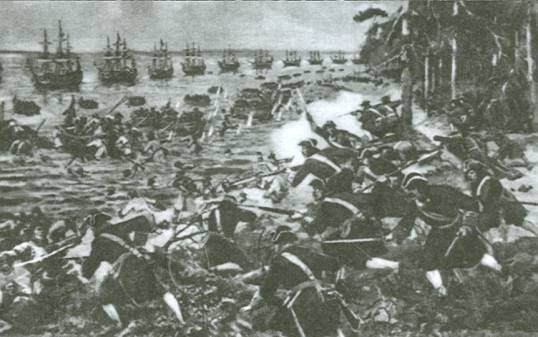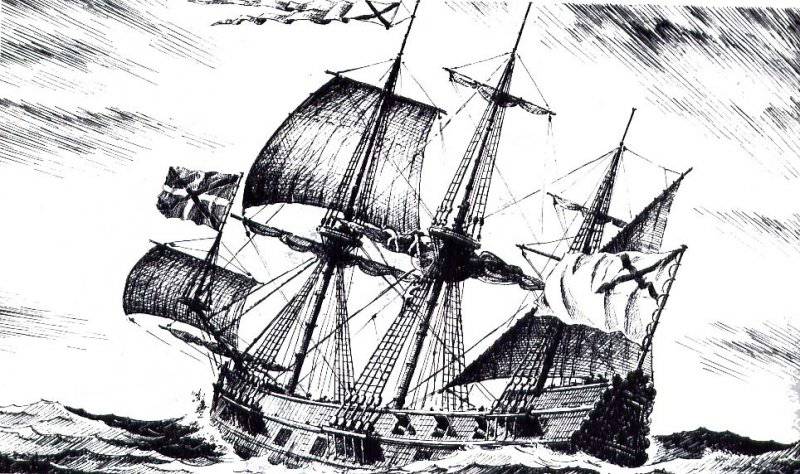Questions of the defense of the Neva delta and the battle for Kotlin

Immediately after the capture of the entire Neva current and access to the shores of the Gulf of Finland, Peter decided to firmly establish himself on these lands. Given the fact that the Swedish empire had powerful naval forces, the Russian command paid special attention to protection from the sea. In the eastern part of the Gulf of Finland and in the delta of the Neva River they begin to create an extensive and deep coastal defense system. In accordance with these considerations, a number of fortifications and coastal batteries were built in 1703 and in the following years: in May, the Peter and Paul Fortress was erected on 1703, in addition, a battery of Vasilevsky Island, Kronslot, Kronstadt coastal batteries appeared harbors, first and second battery Tolbukhina.
Peter and Paul Fortress began to be built on one of the small islands of the Neva delta (on the Hare Island). Due to extremely tight deadlines, which made it impossible to build fundamentally, earthworks were first erected. Artillery of the Peter and Paul Fortress was tasked with a massive fire to repel attempts by the Swedish Navy to move up the Neva. Already in 1706, they began to build stone bastions with casemated batteries. Work on the construction of the fortress was finally completed only in 1740 year. The fortress has become a powerful stronghold with long-term fortifications, armed with which was up to 300 guns. The fire engagement with the coastal battery of the Vasilyevsky Island gave a considerable for that time density of artillery fire. The coastal battery of Vasilyevsky Island was built in June 1703 of the year on the eastern tip of the island, its cannon used to hide the fairway of the Little Neva.
Kotlin played an especially important role in the defense of Petersburg and throughout the Northern War. In the autumn of 1703, Peter, while exploring the sea about 30 km offshore, discovered an island covered with pine forest. He was called Kotlin. The island occupied a strategically important position - approximately in the middle of the bay, between its northern and southern coast. All large vessels were supposed to pass near the island, since in other places extensive shallows blocked the way. The Swedes did not appreciate the importance of the island, so there was not only no fortifications, but also permanent residents in general. On it, the king ordered to build an advanced fort, protecting St. Petersburg from the sea. In the winter of 1703-1704, infantry regiments under the command of F. Tolbukhin and I. Ostrovsky were transferred to Kotlin. First of all, a fortification was built on the shallows to the south of the island, a mound with a large three-tier tower with 14 guns was built on it (their number was soon brought to 30). Then they built a fortification and a battery on the southern coast of the island - the so-called. New Kronshlot. Thus, any enemy ship passing through the southern fairway inevitably fell under the cross fire of the guns of the Kotlin batteries and Kronshlot guns. 7 (18) in May 1704, a celebration took place, the fortress was consecrated and named Kronslot (from the Netherlands. Kronslot - “crown castle”). The main architect of the fortress was the Italian architect and engineer Domenico Trezzini.
The work was going on so intensely that the Swedes were surprised to find the next navigation in the Gulf of Finland, which they had recently considered completely their own, from which the Russian fortress appeared, which closed their approach to the Neva Bay.
It should be noted that It was an innovative step - the creation of coastal batteries on a specially created island. Later, using the experience of building the Old Kronshlot, the Russian builders built other island forts. This idea (the construction of strongholds with artificial grounds) was then borrowed from Russia and the states of Western Europe.
The old battery was erected already in the summer of 1704, on the coast of the island opposite Kronschlot. The battery was supposed to defend the deep-water channel leading to St. Petersburg and the eastern side of Fort Kronslot. The old battery could interact with the Kronschlot artillery and the Ivanovo battery. On the Old Battery installed 8 guns. The Ivanovo battery was erected on the cape of the southern coast of the island of Kotlin, north-west of Kronschlot. She was supposed to interfere with the approach of the enemy ships to the island, shoot through the raid, protect the fairway along with the Old and Lesnaya batteries (initially there were four 6-pound guns, then installed ten 24-pound guns).
In June, the 1705 of the year on the southern bank of the Kotlin, west of the Ivanovo battery, erected a Forest battery with 9 guns. By this the possibility of a breakthrough to Petersburg was further reduced. Forest battery could interact with the Ivanovo battery. The Swedish Navy, trying to break through, would be in a disadvantageous position, it was possible to conduct concentrated fire from several directions at once on the ships.
In the winter of the 1704-1705 of the year, the Swedish Navy was intensively preparing to capture Kotlin and attack Kronslot. Considering the danger of the landing of the Swedish assault, the Russian command in May 1705 of the year transferred an infantry regiment under the command of Colonel Tolbukhin to the area of possible landing of the enemy troops. He was given the task of repelling attempts to land assault on the island. The colonel ordered to put three regimental 3-pound cannons on the prominent cape of the western tip of the southern coast of the island, well disguised.
During the battles with the Swedish fleet in the summer of 1705 it became clear that the defense of the western tip of the island urgently needed to be strengthened. Therefore, twelve 6-pound guns were handed over to Tolbukhin. Two of the new guns strengthened the already created battery (it was called Tolbukhin battery No. 1). And the remaining ten guns were put on the Kotlinskaya Spit. So the battery of Tolbukhin No. 2 appeared. It must be said that the guns of both batteries were mounted on specially constructed carriages that looked like sledges. This made it possible to quickly move the guns and concentrate maximum fire in the most dangerous direction. As a result, the battery of Tolbukhin No. 2 could shoot both fairways - south and north with all guns at once. At the end of June 1705, her efforts were increased by another five 6-pound guns, increasing the number of battery trunks to 15.
In addition, it should be noted that the Tolbukhin’s batteries were viewed by the Russian command more as anti-amps. This is evidenced by a small caliber of guns, a significant number of infantry formations in the area. It should also be said that when building Tolbukhina batteries for the first time in stories The advanced idea of creating mobile coastal artillery was put forward and practically implemented.
Reflection of the Swedish attack on Kotlin in 1704 - 1705
The first attack was repelled already in 1704. Once in 1703, the Russian army captured the entire course of the Neva River, its delta, the Karelian Isthmus to the r. Sister and part of the southern coast of the Gulf of Finland, the Swedish defensive line was cut. The Russian army had the opportunity to develop an offensive along the coast of the Gulf of Finland. This factor, as well as the Russian presence of such important strongholds as Petersburg and Kronslot, forced the Swedes to take measures in order to restore the land connection between Swedish Finland and the southern coast of the Gulf of Finland. The Swedish command decided to capture Kotlin and St. Petersburg. It should be noted that the Swedes still underestimated the successes of the Russian armed forces and for the ground operation small forces were commanded under the command of Meidel, who could not do anything useful.
9 June 1704, Vice Admiral de Pré’s squadron appeared on the horizon: one battleship, five frigates and eight small ships. June 12 Swedish squadron attempted to land troops on the island of Kotlin. 50 Swedish boats came to the island, but they could not go straight to the coast because of the shallow depth. Swedish troops landed in the water and to the waist in it moved to the land. At that moment they were met by a sudden rifle salvo. Swedish soldiers did not expect to meet the enemy on an empty island and retreated. After that, the Swedish squadron moved to Kronshlot and an artillery firing took place for two days. Neither the fort nor the Swedish ships suffered serious damage. On the third day, the Swedes retreated and no longer appeared in 1704.
At this time, the Russian command strengthened the coastal defense with the help of the first ships of the Baltic Fleet. On Syasi, in Ladoga and Svir, work on the construction of warships was in full swing. In the fall, the first ships arrived on the Neva River to St. Petersburg. In the spring of 1705, new ships arrived. By May, the Russian Navy in the Baltic had 20 pennants: eight 24-gun frigates ("Standart", "Narva", "Petersburg", "Kronslot", "Shlisselburg", "Triumph", "Mikhail Archangel", Defam), several 12-gun ships and galleys. Two infantry regiments were planted on the galleys. The ships had 270 guns and 2200 man crews. The squadron was led by Vice Admiral Cornelius Cruys (1655 - 1727), the Norwegian became the first commander of the Baltic Fleet. In addition, the artillery batteries were reinforced, the garrisons of St. Petersburg, Kotlin and Kronschlot were brought to 13 thousand people. The third regiment was transferred to Kotlin.
28 gun frigate "Archangel Michael".
The Swedes took the errors into account, and a more powerful fleet was sent to the Kotlin attack in 1705 — the ship’s 22 (including seven 54-64-gun ships, six 36– and 28-gun frigates, two bombardment ships) under the command of Admiral Cornelius Ankersterna, Vice-Admiral de Prou and Rear-Admiral Shpard were his deputies. When the squadron was a transport fleet of 550 transport ships and landing squad. The land corps of Meidel was supposed to repeat the attack from Finland.
22 May 1705, the Russian squadron left St. Petersburg and arrived at Kronslot on the same day. The main forces of the Baltic Fleet were concentrated on the deep-water channel between the island and Kronshlot. In the immediate vicinity of the Russian ships were the Old and Ivanovo batteries and the fort of Kronschlot. These batteries and guns of the squadron created a very significant density of fire. In addition, to the south of the Ivanovo battery installed a line of floating barriers. Four galleys that could attack enemy ships for boarding were located near Kronschlot.
All these measures were taken very timely. Already at dawn 4 June, the Swedish ships anchored three miles west of Kronschlot. The Swedish squadron on the move tried to break through, approaching the line of obstacles and starting firing. But the well-aimed volleys of the Russian ships and the Ivanovo battery forced the Swedish vanguard to withdraw.
June 5 Swedish ships continued unsuccessful shooting at the Baltic Fleet ships and coastal batteries in the Kronschlot area. At the same time, the ships of the Shpar detachment fired at the western tip of the island and threw assault forces on 80 punt under the command of Colonel Nyrod on Kotlin. But the Tolbukhin battery X-ray cartoons and the accurate rifle fire of the infantry regiment inflicted considerable losses on the Swedish troops and forced the enemy to panic retreat. 1 Swedes were killed and 40 captured.
June 6 continued artillery fire with batteries Kronshlot, but the Swedes did not achieve. 7-9 June, the Swedes did not take active steps and discussed the future plan of their actions. The active defense of the Russians embarrassed them, becoming for them a complete surprise. The Swedes were counting on a quick victory. But they were not going to retreat, having decided to break the Russian defense at all costs and break through to the mouth of the Neva. The Russian command at this time strengthened its batteries on the island.
10 June, the Swedes again went on the attack. Admiral Shpar's detachment approached the barricades and, moving closer to the Russian ships at a distance of artillery fire, began a firefight. But soon the Shpar detachment was forced to retreat under the fire of the Ivanovo battery and joined the ships of Ankershtern, who fired at Kronslot, and the ships of the Baltic Fleet that were near him. Despite the fact that the Swedish artillerymen had more powerful artillery and the number of guns, there were few hits in Russian ships and batteries. The Russian artillerymen, especially from coastal batteries (the crews of the ships were inexperienced, there was also a shortage of crews), achieved great success. When the wind died down, the Russian galleys attempted to storm the enemy bombardier ships, the two-three-masted ships, intended to bombard the coastal fortifications and the coastal fortresses of the enemy, and, to a lesser extent, for enemy artillery combat with enemy naval ships, were armed with large-caliber guns. The Swedes were forced in boats to drag them to their main forces.
At the same time, the attempt by General Meidel to attack Petersburg from land also failed.
The Swedish fleet anchored off the wooded shore of the Kotlin beyond the reach of Russian batteries, repairing damaged ships. The Russian command took into account that the enemy had already parked there several times, and secretly installed a new battery (Forest Battery). June 15 Swedes unexpectedly fired at them. The Swedes were forced to retreat.
June 21 The Swedish squadron left the island for Biorke and returned only in the morning of July 14. The Swedes went on a decisive assault. But the Russian command didn’t sleep and was well prepared - the first Tolbukhin battery was strengthened, the second one was created, earthworks were carried out to protect the infantry from the ship artillery fire.
The Swedish squadron opened heavy fire, trying to suppress the Tolbukhin battery No. 2 and sweep away the infantry formations covering this area. But they did not have much success - the guns and infantry were well disguised, located in low-lying, sheltered places. Moreover, four Russian guns could cause significant damage, damaged the flagship of the Swedes. After the shelling, an amphibious detachment was thrown into the battle - 1,6-2 thousand soldiers. Halfway between the squadron and the coast, a cannon disguised and unresponsive to the fire of enemy ships was hit with canister. The Swedes survived and, coming up on the 50-70 meters to the shore, began to disembark from the boats. When part of the Swedish paratroopers reached the coast, they were met by a rifle salvo and bayonet attack by the soldiers of Tolbukhin and Ostrovsky. The Swedes could not stand the blow and rushed to run. It was a defeat - about 1 thousand Swedes were killed, wounded or captured (some drowned). The Swedish fleet did not repeat any more attempts to attack and left.
It was a feat that even foreigners could not keep silent. The English envoy to Russia reported to London that the Swedes had lost up to six hundred killed in a hot fight, and Admiral Ankersternn ordered to shoot from the ships at his landing party so that he would return to the shore, but this only exacerbated the confusion.
Results
- In tactical terms, both sides acted rather indecisively and could not achieve complete victory. But the Russian command prevailed, skillfully interacting with coastal batteries, naval forces, infantry, using innovations such as artillery ambushes, auxiliary water obstacles.
The Swedish command, despite superiority in manpower and equipment, did not show full determination in achieving the goal; artillery attacks on coastal objects were carried out from long distances, and could not organize effective interaction between the Navy, powerful naval artillery, paratroopers and ground forces.
- It was a great strategic victory for the Russian army and the Baltic Fleet, Russia was able to stand firmly on the shore of the Baltic.
- After the victory, the Russian command even more strengthened the defensive order: at the beginning of 1706, the king ordered to found a small fort called "St. Alexander" on the western tip of Kotlin Island in place of the Tolbukhin batteries, 40 was armed with cannons; in the year 1710, construction of the seaport began on the island, and coastal batteries of the Kronstadt harbors began to be built from 1713, by the time 1720 had 120 guns on them. In 1723, the "Main Fortress" was laid (they began to call it Kronstadt). By 1725, on the island and in Kronstadt in the artillery park there were 335 guns, the fortress garrison made up two infantry regiments with a total number of 2,7 thousand people. Kronstadt became a reliable fortress, a shield of the northern capital of the Russian Empire.


Information